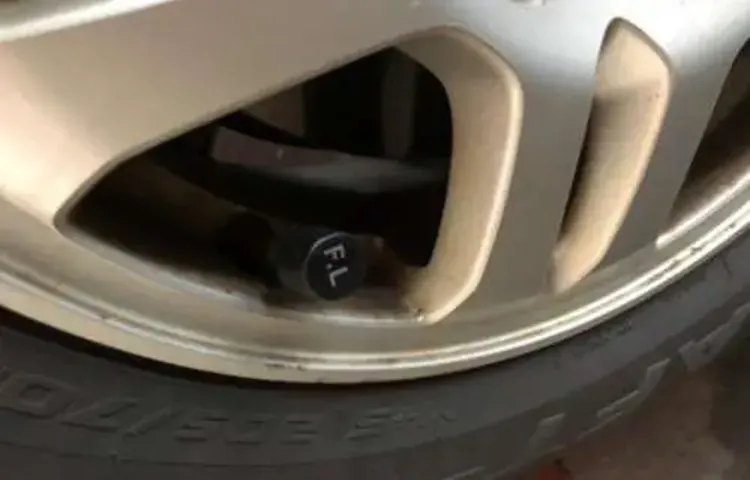Do you keep getting alerts on your dashboard indicating low tire pressure even after inflating your tires? Perhaps it’s time to check if your tire pressure sensor is bad. Tire pressure sensors are an essential component of modern cars and are responsible for monitoring the air pressure in your tires. A faulty sensor can cause a significant inconvenience, making it vital to know how to identify if it’s malfunctioning.
In this blog, we’ll share some tips on how to tell if a tire pressure sensor is bad and what to do next. So, take a deep breath, and let’s dive in!
Table of Contents
Understanding Tire Pressure Sensors
As a driver, it’s essential to understand your tire pressure sensors to ensure that your car is safe on the road. One of the telltale signs that a tire pressure sensor is bad is if your car’s TPMS warning light illuminates on the dashboard. This light is an indicator that one or more of your tires needs air.
If you check your tire’s pressure, add air if necessary, and the light remains on, then that’s when it’s a good idea to inspect your tire pressure sensors. A bad sensor can cause inaccurate readings or fail to read the pressure altogether. When this happens, it’s necessary to replace the sensor.
Regularly checking your tire’s pressure and inspecting your sensors can help avoid unexpected flat tires or blowouts, which is why it is crucial to invest time and effort in maintaining your vehicle’s tire pressure system.
What is a tire pressure sensor?
A tire pressure sensor is a small electronic device that is mounted on the inside of a tire’s rim. It is designed to monitor the air pressure in each tire of a vehicle and to alert the driver when the pressure drops below a certain level. This is important because a tire with low pressure can cause a vehicle to handle poorly, decrease fuel efficiency, and even cause a blowout.
The sensors can also help to improve vehicle safety by warning the driver of a potential problem before it becomes a major issue. Overall, tire pressure sensors are an important feature that can help to ensure safe and efficient driving. So, if you want to keep your vehicle in top-notch condition, be sure to check your tire pressure regularly and take advantage of this technology.

How does it work?
Tire Pressure Sensors Have you ever wondered how your car knows when your tires need more air? Tire pressure sensors are the answer. These small devices are located inside each of your tires and monitor the air pressure. They then send a signal to your car’s onboard computer, which displays the tire pressure on your dashboard.
This technology has been around for a while, but it is becoming more common in newer cars. Not only does it alert you when your tires are low, but it can also help improve your car’s fuel efficiency and overall performance. By keeping your tires at the right pressure, you can prevent unnecessary wear and tear, and make your driving experience safer and smoother.
So, the next time you see that warning light on your dashboard, you’ll know it’s time to add some air to your tires, thanks to those handy pressure sensors.
Signs of a Bad Tire Pressure Sensor
Are you wondering how to tell if a tire pressure sensor is bad? There are a few signs that you should look out for. The first is if the sensor light on your dashboard stays on even after you’ve checked and adjusted your tire pressure. Another sign is if the sensor light turns off but then comes back on shortly after.
You may also notice that your tire pressure readings are consistently inaccurate or fluctuate rapidly. If you suspect that your tire pressure sensor is malfunctioning, it’s important to have it checked out by a professional to ensure that your vehicle’s safety features are working properly. Don’t let a bad tire pressure sensor compromise your safety on the road.
TPMS Malfunction Indicator Light
If you’ve noticed the TPMS malfunction indicator light illuminate on your dashboard, it could be a sign that your tire pressure sensor isn’t functioning properly. This light typically comes on when there’s a mismatch between the recommended tire pressure and the actual pressure, which can cause a variety of problems, including decreased fuel efficiency and an increased risk of tire blowouts. Having a bad tire pressure sensor can be frustrating and concerning, especially if you rely on your car for daily transportation.
Some signs of a bad tire pressure sensor include inaccurate readings, slow or non-responsive readings, or a completely dead sensor. If you suspect your sensor is malfunctioning, it’s important to get it checked out by a professional to ensure your safety on the road and the longevity of your tires. Don’t ignore the TPMS malfunction indicator light – address the issue as soon as possible to avoid potential hazards and costly repairs.
Inaccurate Tire Pressure Readings
One of the most common issues that drivers face is inaccurate tire pressure readings. If your tire pressure sensor is faulty, you may start noticing a number of warning signs. For instance, your tire pressure monitor light may come on frequently even when you’ve just filled up the tire.
Your tires may also seem to be underinflated or overinflated despite regular checks and adjustments. You may also notice that your car is handling differently than usual or that it’s using more gas than usual. If you’re experiencing any of these symptoms, it’s possible that your tire pressure sensor needs to be replaced.
This is a relatively easy fix and it’s worth getting it done to ensure that your tires are always at the right pressure.
Sudden Changes in Tire Pressure
As a car owner, it’s important to pay attention to sudden changes in tire pressure. One possible reason for this could be a bad tire pressure sensor. Signs of a faulty sensor may include the tire pressure warning light coming on even when the tire pressure is okay, or the warning light not coming on even when the pressure is low.
Additionally, you may notice that the pressure in one tire is significantly different from the others, or that the pressure fluctuates unexpectedly. If any of these signs sound familiar, it’s a good idea to bring your car in for a service appointment. A technician can diagnose the issue and replace any faulty parts.
Not only will this help keep you safe on the road, but by maintaining proper tire pressure, you’ll also improve your car’s fuel efficiency. So don’t ignore those warning signals – take your car into the shop and get it checked out.
How to Test Your Tire Pressure Sensor
If you’re wondering how to tell if a tire pressure sensor is bad, there are a few things you can do to test it. The first step is to check the pressure of your tires with a reliable gauge. If the readings are accurate but your dashboard warning light remains on, it’s possible that one or more of your sensors may be malfunctioning.
Another way to check is to inspect each sensor for physical damage or corrosion, as this can also cause problems. If you’re still unsure, you can take your car to a mechanic who can use specialized equipment to diagnose any issues with your tire pressure sensor. Remember, a faulty sensor can affect your car’s performance, fuel efficiency, and even your personal safety on the road.
So it’s always better to be safe than sorry and make sure your sensors are in good working order.
Using a TPMS Scan Tool
If you want to ensure your tire pressure sensor is working properly, a TPMS scan tool is an invaluable tool to have. This device allows you to scan each tire individually to check the pressure and temperature, giving you an accurate reading of your tire sensors. With this information, you can easily identify any tire that may need additional air or maintenance, saving you time and money in the long run.
Using a TPMS scan tool is straightforward, simply plug it into your car’s OBD-II port, select the appropriate functions, and you’re good to go. By regularly using a TPMS scan tool, you’ll be able to maintain your tires and ensure a safer and smoother ride on the road. So, if you’re looking to take better care of your tires, investing in a TPMS scan tool is definitely worth considering.
Checking the TPMS Fuse
If you’re noticing issues with your tire pressure monitoring system (TPMS), one of the first things you can do is check the TPMS fuse. The TPMS fuse helps to power the system, so if it’s blown or damaged, it can cause problems with your sensors. To test the TPMS fuse, start by locating the fuse box in your vehicle and finding the TPMS fuse.
Use a fuse tester or multimeter to check the continuity of the fuse. If it’s damaged or blown, replace it with a new fuse and see if that fixes the issue. Keep in mind that there could be other reasons for problems with your TPMS, such as faulty sensors or a malfunctioning control module.
If replacing the fuse doesn’t solve the problem, it may be time to take your vehicle to a mechanic.
Assessing the Battery Status of the TPMS Sensor
Testing Your TPMS Sensor to Assess Its Battery Status Have you ever wondered how to test your tire pressure monitoring system (TPMS) sensor? It’s essential to know how to assess the status of your TPMS sensor’s battery. A tire pressure monitoring system helps keep your vehicle safe by warning you if there is a drop in tire pressure. A low tire pressure can lead to a tire blowout, loss of control, and even a severe automobile accident.
Fortunately, testing your TPMS sensor battery status is something that you can do yourself. First, you’ll need to locate the TPMS sensor, which is mounted inside each tire. Once you’ve found it, you’ll need to remove the sensor from your car and locate the battery.
After locating the battery, use a voltmeter to test its voltage. If the voltage is below 93 volts, you should replace the battery.
It’s important to replace the battery immediately to ensure that your TPMS sensor works correctly. A TPMS sensor battery typically lasts around five to ten years, depending on usage. In summary, keeping your TPMS sensor in good working order is essential to your safety.
With a bit of knowledge, you can test the battery status of your TPMS sensor yourself. It’s a straightforward process that can save you time, money, and possibly even save your life. Remember to perform this vital check periodically to ensure that your TPMS sensor is functioning optimally.
Conclusion
In conclusion, the easiest way to tell if your tire pressure sensor is bad is to trust your gut. If you feel like something is off, get it checked out. Of course, there are more scientific ways to diagnose a faulty sensor, such as checking the tire pressure directly or using a diagnostic tool.
But sometimes, our intuition is all we need to know that something is not quite right. So, don’t ignore those nagging feelings – take care of your tires and trust your instincts!”
FAQs
What are the common signs of a bad tire pressure sensor?
The common signs of a bad tire pressure sensor include the tire pressure warning light staying on, inaccurate readings, and a failure to alert the driver of low tire pressure.
How can I check if my tire pressure sensor is working properly?
To check if your tire pressure sensor is working properly, you can use a tire pressure gauge to measure the actual tire pressure and compare it to the reading displayed on the monitoring system. If the readings are significantly different, your tire pressure sensor may be faulty.
Can a bad tire pressure sensor cause other problems with my vehicle?
Yes, a bad tire pressure sensor can cause other problems with your vehicle, such as reduced fuel efficiency, uneven tire wear, and poor handling.
How long do tire pressure sensors last?
Tire pressure sensors can last anywhere from 5 to 10 years, depending on the make and model of your vehicle and the quality of the sensors.
Can I replace a tire pressure sensor myself?
It is possible to replace a tire pressure sensor yourself, but it requires specific tools and knowledge. It is recommended to have a professional mechanic or technician replace the sensor for you.
How much does it cost to replace a tire pressure sensor?
The cost to replace a tire pressure sensor varies depending on the make and model of your vehicle and the location of the sensor. On average, the cost can range from $50 to $250 per sensor.
Are tire pressure sensors necessary for safe driving?
While tire pressure sensors are not necessary for safe driving, they can help prevent accidents by alerting the driver to low tire pressure and other issues that may affect handling and performance.



